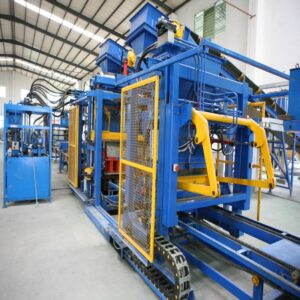Handling variations in local power supply specifications is crucial for the performance and reliability of a hollow block machine.
Here’s how a machine might address this issue:
- Voltage Compatibility: The machine should be designed to operate within a range of voltage specifications commonly found in different regions. This could include accommodating voltages such as 110V, 220V, 380V, or others, depending on the local standards.
- Voltage Regulation: Some machines may incorporate voltage regulation or stabilization features to ensure consistent power supply despite fluctuations in the grid. Voltage regulators or stabilizers help maintain a steady voltage output, protecting the machine from damage due to overvoltage or undervoltage conditions.
- Frequency Compatibility: In addition to voltage, the machine should also be compatible with the frequency of the local power supply. Common frequencies include 50Hz and 60Hz, and the machine’s components should be designed to operate effectively within these ranges.
- Power Factor Correction: Advanced machines may include power factor correction (PFC) technology to optimize power efficiency and reduce reactive power consumption. PFC helps improve the overall power quality and stability of the machine’s operation, especially in environments with poor power factor conditions.
- Adaptive Control Systems: Some modern machines may feature adaptive control systems that can automatically adjust operational parameters in response to changes in the power supply. These systems can optimize performance and protect the machine from damage under varying power conditions.
- Built-in Protections: The machine should incorporate built-in protections such as surge protection, overcurrent protection, and voltage spike suppression to safeguard sensitive electronic components from damage caused by power surges or transients.
- Compatibility with Backup Power Sources: For areas with unreliable or intermittent power supply, the machine may be designed to interface with backup power sources such as generators or uninterruptible power supply (UPS) systems. This ensures continuity of operation even during power outages or blackouts.
- Compliance with Standards: The machine should comply with relevant international and local standards for electrical safety, electromagnetic compatibility (EMC), and power quality. Compliance with standards ensures that the machine is designed and tested to operate safely and reliably under specified power conditions.
By incorporating these features and considerations, a hollow block machine can effectively handle variations in local power supply specifications, ensuring consistent and reliable operation in diverse geographical regions and power environments.
How does concrete block making equipment handle variations in humidity and temperature?
Concrete block making equipment must be designed to handle variations in humidity and temperature to ensure consistent and reliable performance.
Here are several ways in which such equipment can address these challenges:
- Material Selection: Utilize materials for the construction of the equipment that are resistant to changes in humidity and temperature. This includes selecting corrosion-resistant metals, durable plastics, and sealing materials that maintain their properties under different environmental conditions.
- Climate Control Systems: Incorporate climate control systems into the equipment’s design to regulate the internal temperature and humidity levels. This may include heating elements, air conditioning units, or dehumidifiers to create a controlled environment within the equipment.
- Insulation: Provide adequate insulation for critical components of the equipment to minimize the impact of external temperature fluctuations. Insulating materials can help maintain stable operating conditions and protect sensitive components from temperature extremes.
- Sealing and Enclosures: Seal critical components and electrical connections to protect them from moisture ingress due to high humidity levels. Enclose vulnerable parts of the equipment in protective housings or enclosures to shield them from environmental elements.
- Ventilation Systems: Install ventilation systems to ensure proper air circulation within the equipment, which helps regulate temperature and prevent the buildup of moisture. Ventilation can also aid in dissipating heat generated during operation, maintaining optimal operating conditions.
- Drying Chambers: Incorporate drying chambers or preheating zones into the equipment to prepare raw materials such as aggregates or cementitious mixes for processing. These chambers can help control the moisture content of the materials and ensure consistent block quality.
- Process Optimization: Optimize the manufacturing process to accommodate variations in humidity and temperature. This may involve adjusting mix designs, curing times, or production parameters to account for changes in environmental conditions and maintain product quality.
- Monitoring and Control Systems: Implement monitoring and control systems to continuously track environmental conditions such as humidity and temperature. These systems can provide real-time feedback to operators and automatically adjust equipment settings to optimize performance.
- Quality Assurance Measures: Implement rigorous quality assurance measures to detect and mitigate any adverse effects of humidity and temperature variations on the final product. This may include regular testing of concrete block samples to ensure compliance with specifications.
- Training and Maintenance: Train equipment operators on proper maintenance procedures and best practices for operating the equipment in different environmental conditions. Regular maintenance checks and inspections can help identify and address any issues related to humidity and temperature control.
By incorporating these features and considerations into the design and operation of concrete block making equipment, manufacturers can ensure that the equipment can effectively handle variations in humidity and temperature, resulting in consistent and high-quality block production.
